Chapter by:
Jansen A. Smith, Paleontological Research Institution, Ithaca, New York
This chapter was first publicly shared on
Chapter citation:
J.A. Smith. 2020. Arthropoda. In: The Digital Encyclopedia of Ancient Life. https://www.digitalatlasofancientlife.org/learn/arthropoda
Chapter contents:
Arthropoda ←
–– 1. Stem-group Arthropods
–– 2. Trilobita
–– 3. Chelicerata
–– 4. Mandibulata
Above image
Introduction
Arthropoda is the most diverse animal phylum and its members are abundant in many environments. Living arthropods are split into two groups, Chelicerata and Mandibulata. Chelicerates include taxa like spiders, mites, and scorpions, and are defined by the presence of chelicerae—for example, the fangs found in spiders. Mandibulates include taxa like crabs, barnacles, and insects, and are defined by the presence of mandibles—for example, the enlarged mouthparts found in many beetles. Collectively, arthropods are defined by several features, including jointed appendages (arthropod means “joint leg”), an exoskeleton (often made of chitin), and bilateral symmetry (like us). Watch the video below to see some of these features in living specimens.
Learn more about key arthropod features in this video, "What is an Arthropod?" by Smithsonian Education (YouTube). Note, the five groups discussed in this video highlight the diversity of arthropods but do not reflect current thinking on phylogenetic relationships. Millipedes and centipedes belong to Myriapoda. Crustaceans and insects belong to Pancrustacea. Arachnids are not likely a monophyletic group, but the term is used to refer to a variety of chelicerate groups. Explore the pages in this chapter to learn more about each of these groups.
Fossil Record
The fossil record of arthropods began in the Early Cambrian, approximately 537 million years ago, with the occurrence of arthropod-made trace fossils.
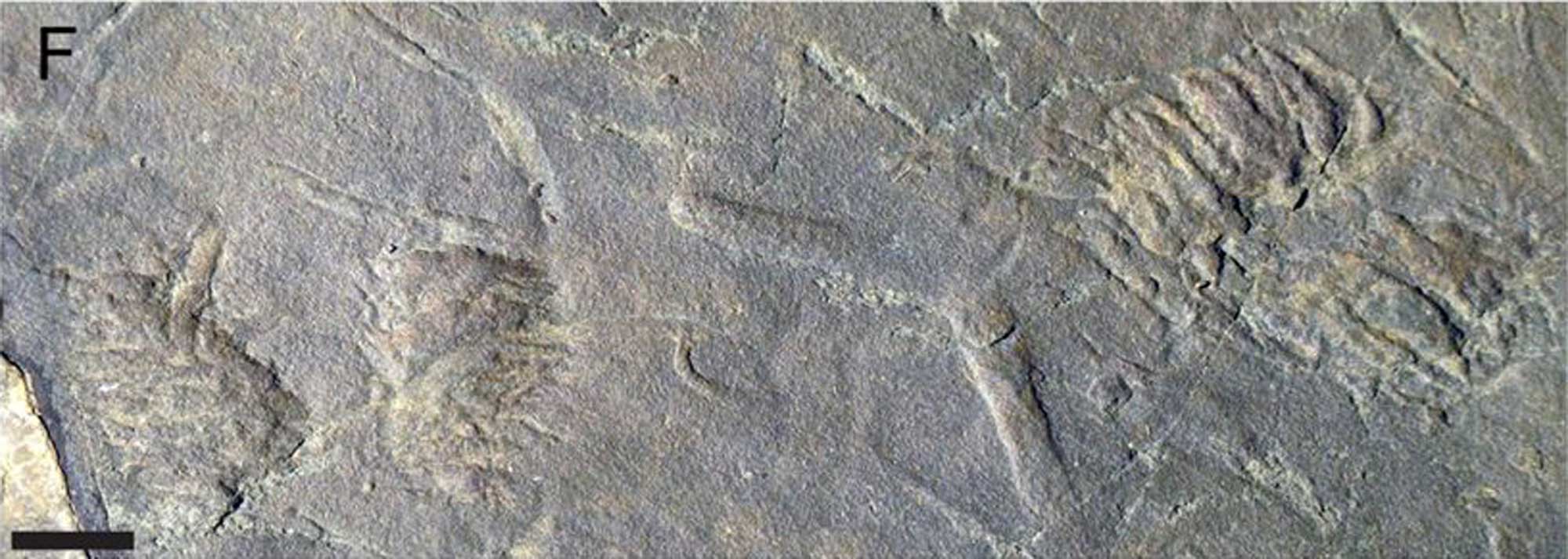
Cambrian trace fossils (Rusophycus) produced by an arthropod provide the oldest evidence in the fossil record for the phylum. Figure 4f from Daley et al. (2018 in Proceedings of the National Academy of Sciences (USA) under the PNAS License to Publish (Copyright (2018) National Academy of Sciences). Original caption: "(F) Earliest total group euarthropod evidence, Rusophycus trace fossil, GSC 85983."
Arthropod body fossils are not known until 521 million years ago, when trilobites first appeared in the fossil record—and from there would go on to be an important member of Paleozoic ocean-bottom communities.
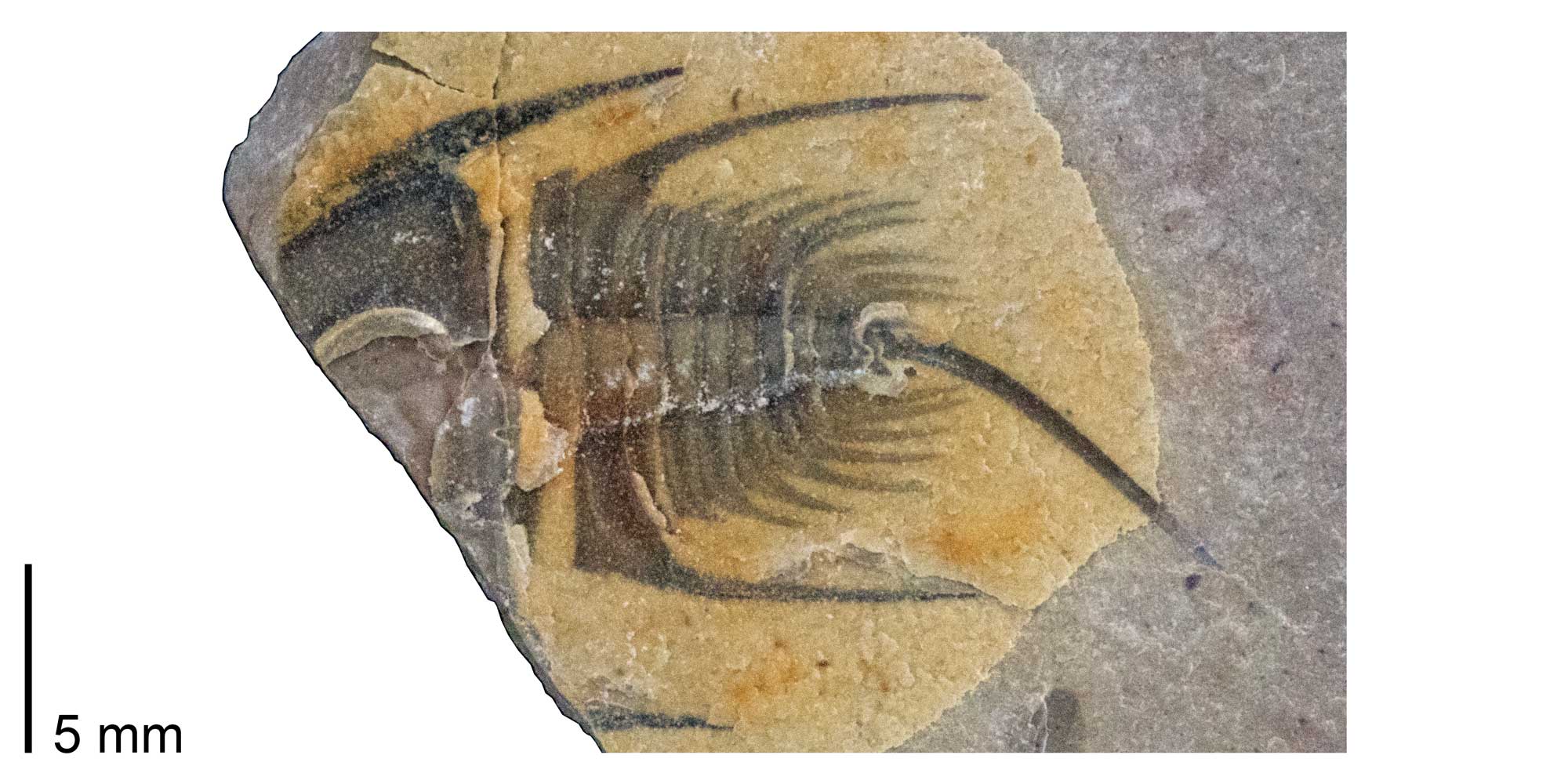
Olenellus gilberti, one of the oldest trilobites from the Early Cambrian Pioche Shale of Nevada (PRI 49807). Image by Jonathan R. Hendricks for the Digital Atlas of Ancient Life project.
Trilobites are generally accepted as crown-group arthropods, which makes it interesting that they are the first arthropods in the record. The first stem-group arthropods—animals that are phylogenetically basal to modern arthropods (e.g., Anomalocaris)—appear 518 million years ago. Considering the trace fossils, and the seemingly out-of-order appearance of stem- and crown-groups in the fossil record, it is highly likely that the earliest arthropod record has not yet been found. Indeed, arthropods likely evolved by at least 550 million years ago, at the very end of the Precambrian.
From the Cambrian onward, arthropods colonized, and have been abundant in, essentially all of Earth’s ecosystems, from the deep ocean to the skies.
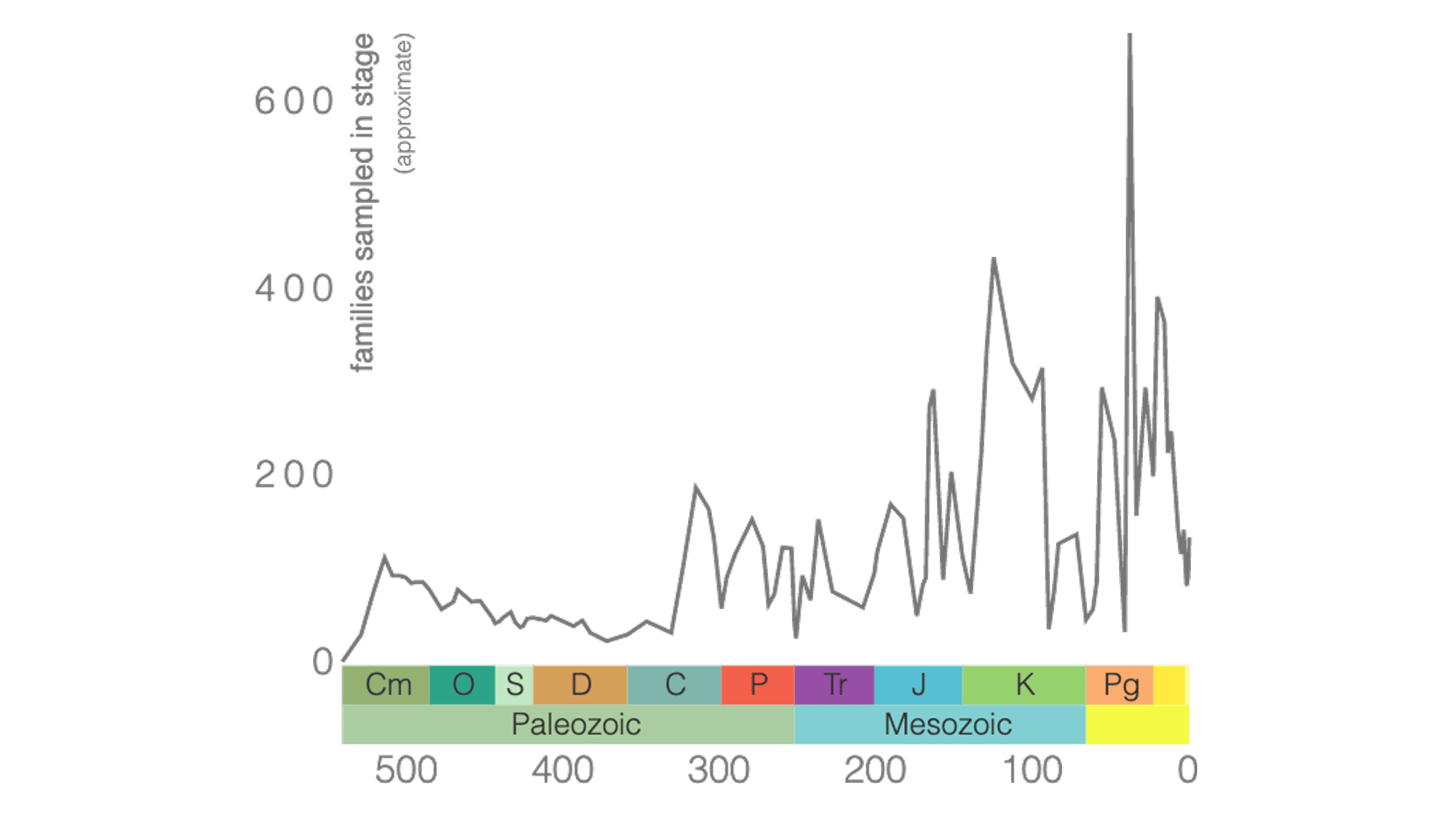
Arthropods with mineralized exoskeletons (e.g., trilobites and some crustaceans) have left behind an excellent fossil record. Most arthropods, however, lack mineralized exoskeletons and are are known as fossils primarily from lagerstätten deposits, wherein exceptional conditions (e.g., rapid burial, no oxygen) led to the preservation of the often-fragile arthropod bodies. Some of the most exceptional arthropod fossils are found encased in amber (i.e., fossilized tree resin), enabling highly detailed study (see figure below).
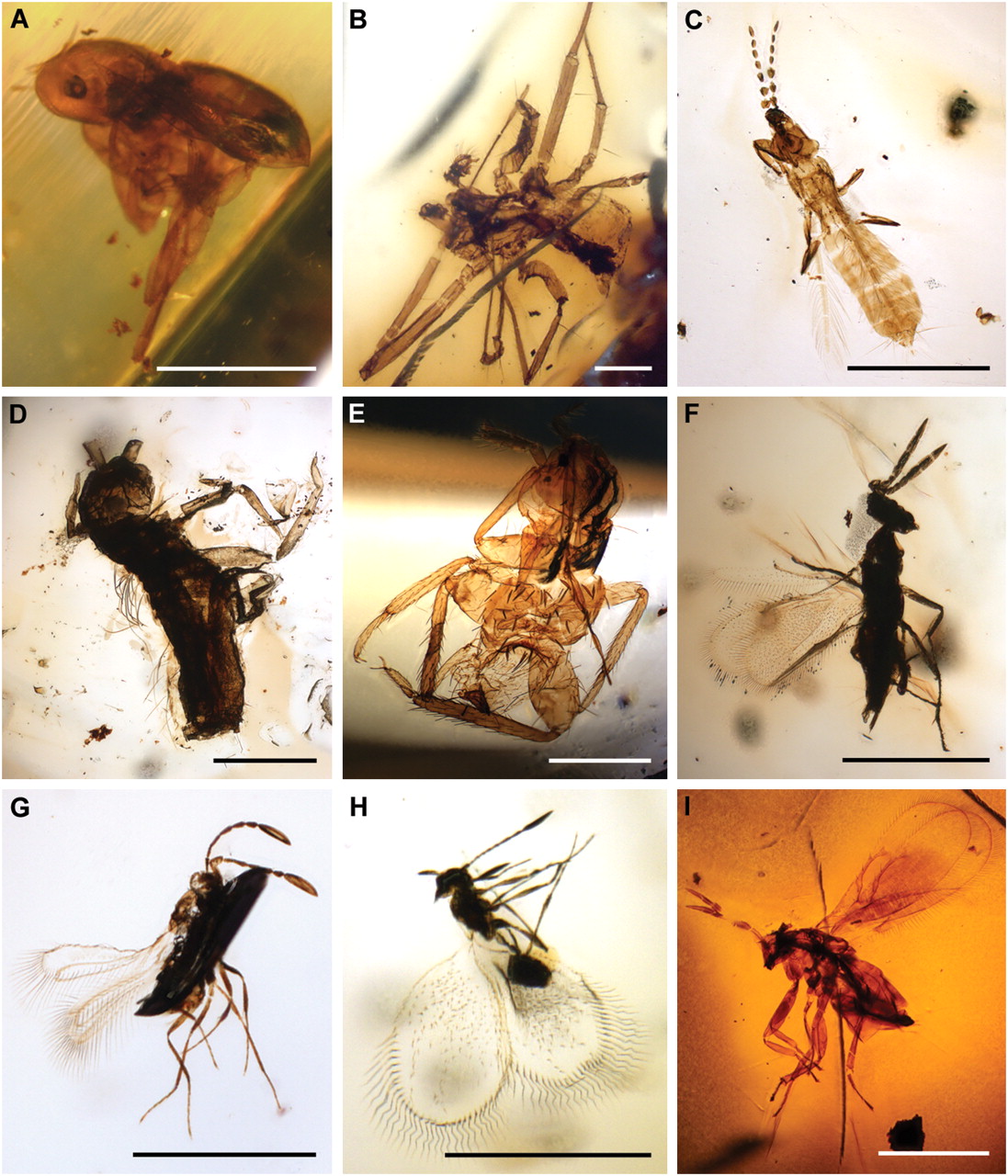
A variety of arthropods preserved in amber from the Cretaceous of Ethiopia. Figure from from Schmidt et al. (2010) in Proceedings of the National Academy of Sciences (USA) under the PNAS License to Publish (Copyright (2010) National Academy of Sciences). Original caption: "Assorted arthropods fossilized in Cretaceous Ethiopian amber. (A) A worker ant (Hymenoptera, Formicidae; NHMW, N6976). (B) A male sheet-web weaver spider (Araneae, Linyphiidae; MB. A 1664). (C) A thrips (Thysanoptera, Merothripidae; NHMW, N6974a). (D) A springtail (Collembola, Isotomidae; NHMW, N6969). (E) A Zoraptera (NHMW, N6991). (F) A wasp of the Eulophidae (Hymenoptera; NHMW, N6966a). (G) A fairy wasp (Hymenoptera, Mymaridae; NHMW, N6970). (H) A false fairy wasp (Hymenoptera, Mymarommatidae; NHMW, N6965a). (I) A representative of the Trichogrammatidae (Hymenoptera; MB. I 5654). (Scale bars: 500 μm.)"
Phylogenetic Relationships
Arthropods belong to a broader group of organisms called Ecdysozoa, which share the characteristic of molting during growth. Because arthropods have a hardened exoskeleton (whether mineralized, or not), they must shed their exoskeleton in order to grow. This process is called molting.
As reviewed by Giribet and Edgecombe (2019), within Ecdysozoa, arthropods are now often grouped with two other phyla, Tardigrada and Onychophora, and form the clade Panarthropoda (see figure below). These groups are united by the presence of paired, segmented appendages and by partitioning of the body into at least two regions, the head and trunk.
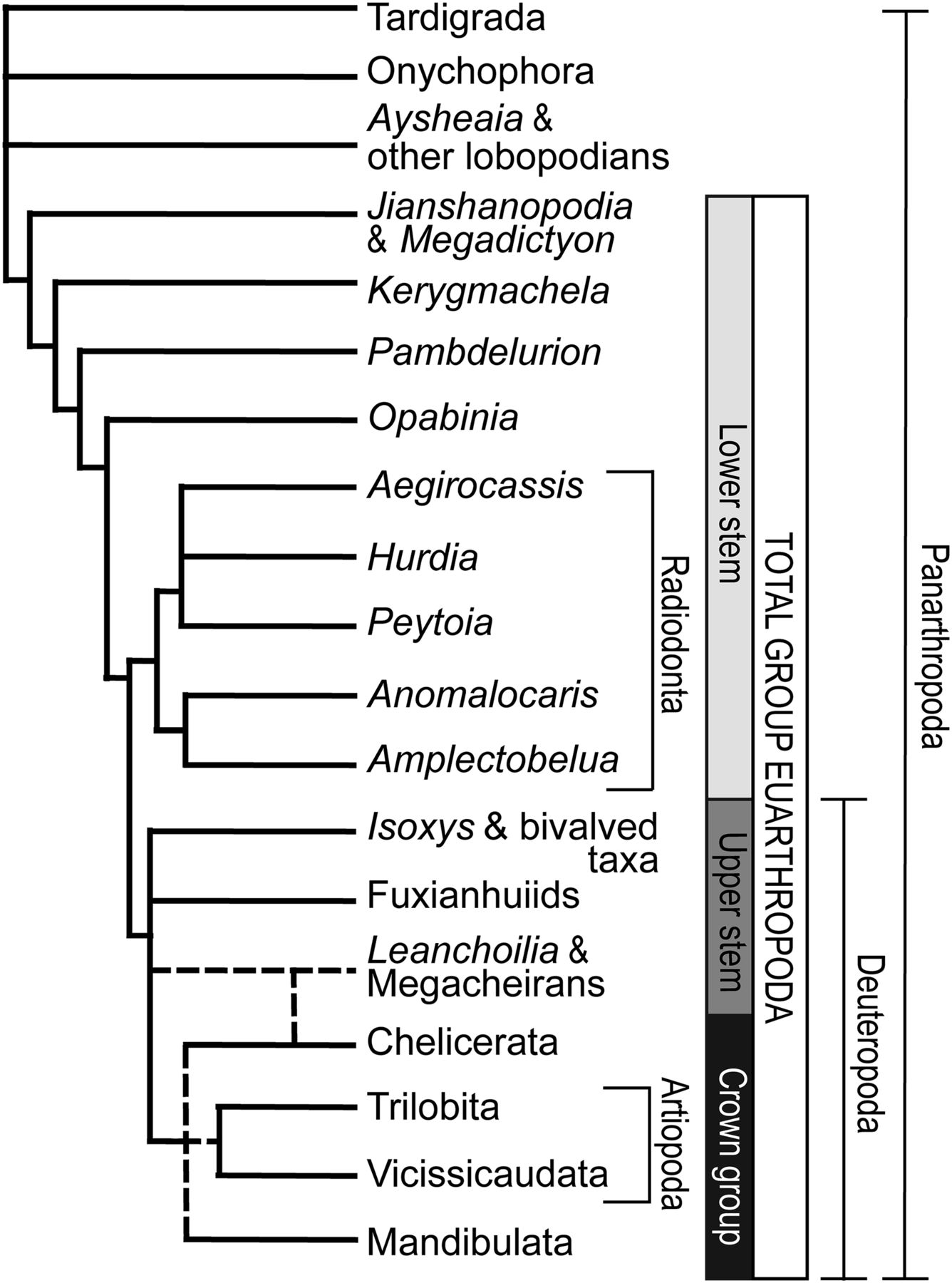
A hypothesis on the phylogenetic relationships of major arthropod groups. "A generalized phylogeny of panarthropod relationships, distinguishing the crown group Euarthropoda from the lower and upper stem lineage euarthropod taxa. Dashed lines indicates the uncertain phylogenetic placements of Megacheira and Artiopoda. Data from refs. 1, 4, 27, 31, 34, and 37." Figure and caption from Daley et al., 2018 in Proceedings of the National Academy of Sciences (USA) under the PNAS License to Publish (Copyright (2018) National Academy of Sciences).
Understanding the relationships between arthropod groups has been a considerable challenge, in no small part because of the vast diversity of fossil and living arthropods. The advent of modern molecular techniques has improved our understanding of these relationships, as many arthropod groups previously had been defined based solely on morphological characters. The complementary information provided by molecular and morphological data has led to greater resolution in the arthropod phylogeny. As shown in the phylogeny above, the familiar arthropods (i.e., Chelicerata, Mandibulata) of today represent only a portion of the arthropod diversity that has existed during the history of life on Earth. On the next page, we will take a closer look at several of the stem-group taxa before during to the Trilobita, Chelicerata, and Mandibulata on the pages that follow.
References and Further Reading
Daley, A. C., J. B. Antcliffe, H. B. Drage, and S. Pates. 2018. Early fossil record of Euarthropoda and the Cambrian Explosion. Proceedings of the National Academy of Sciences of the United States of America 115(21): 5323-5331.
Giribet, G., and G. D. Edgecombe. 2019. The phylogeny and evolutionary history of arthropods. Current Biology, 29: R592-R602.
Schmidt, A. R., V. Perrichot, M. Svojtka, K. B. Anderson, K. H. Belete, R. Bussert, et al. 2010. Cretaceous African life captured in amber. Proceedings of the National Academy of Sciences, 107: 7329-7334.
Usage
Unless otherwise indicated, the written and visual content on this page is licensed under a Creative Commons Attribution-NonCommercial-Share Alike 4.0 International License. This page was written by Jansen A. Smith. See captions of individual images for attributions. See original source material for licenses associated with video and/or 3D model content.



